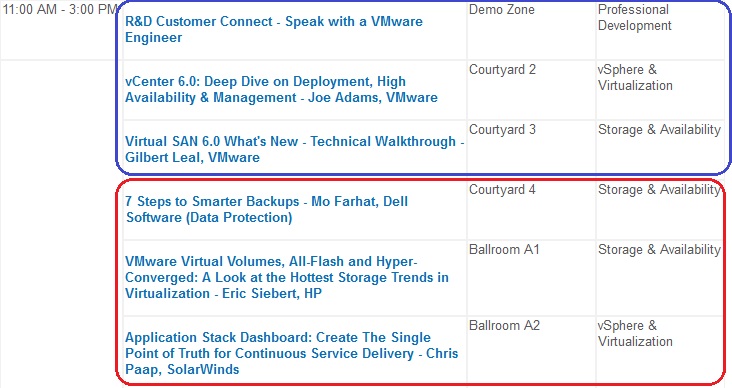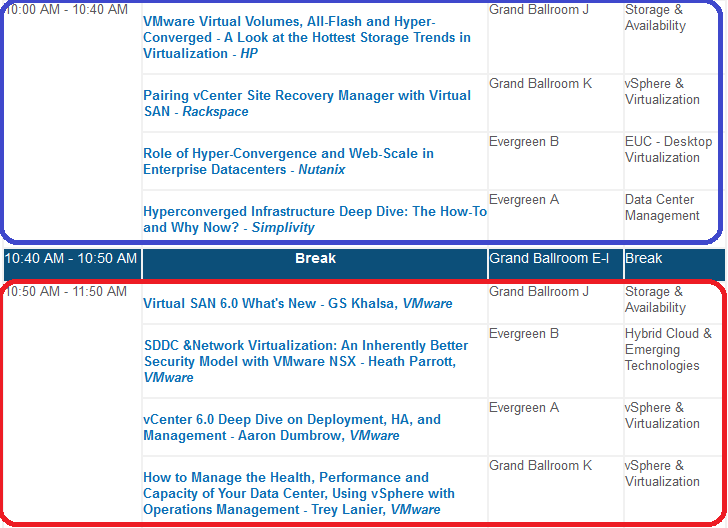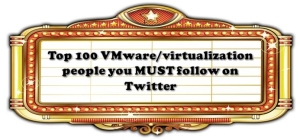ServerWatch recently published a list of the Top 10 Virtualization Experts that you need to follow and I’m honored to be included on that list along with some other very distinguished people that deserve to be there. I can’t dispute any of their choices which includes a dream team of virtualization superstars: Jason Boche, Scott Lowe, Chad Sakac, Rick Vanover, Stephen Foskett, Alan Renouf, Duncan Epping, Chris Wolf and Vaughn Stewart. My only comment is that there are plenty of other people that deserve to be there as well and if you want to see a larger list check out my Top 100 list that I published 6 months ago.
July 2015 archive
Jul 25 2015
A new vChat Episode on Virtual Volumes (VVols)
David, Simon and I recently got together for a new vChat episode and the topic of choice was my favorite topic these days, VVols. We also give updates on what we’ve been up to recently and we promise to be recording more vChat episodes on a regular basis. Also check out David’s link page that references the topics we talk about.
Jul 16 2015
The economics of VMworld party bands
I did a post a few years ago on VMworld bands that I’m updating after the band for this year was announced. Much to my disappoint they failed to get a big name band in favor of two lesser known obscure bands, Neon Trees and Alabama Shakes. I’ve been attending VMworld since 2008 and the official parties have always been a fun way to unwind for a bit and escape after a busy week of hard core virtualization. VMware has had a variety of different bands to play at the party over the years that are listed below:
- 2007 – Smash Mouth (Treasure Island)
- 2008 – DJ & Tainted Love (cover band) (Las Vegas Speedway)
- 2009 – Foreigner (Moscone)
- 2010 – INXS (Moscone)
- 2011 – Killers (Venetian)
- 2012 – Jon Bon Jovi & the Kings of Suburbia (Moscone)
- 2013 – Train and Imagine Dragons (AT&T Park)
- 2014 – The Black Keys (Yerba Buena Gardens)
- 2015 – Neon Trees and Alabama Shakes (AT&T Park)
I like a wide range of music but the only two bands that I really enjoyed seeing at VMworld were INXS and Foreigner which are in the classic rock era that I grew up with. In 2012 I was excited to find out that Jon Bon Jovi was playing which is another band I grew up with but the actual performance I thought was terrible as he played mostly cover songs from other bands and very few Bon Jovi songs. Train in 2013 is an OK band, I like a few of their songs but they are not a band I have a strong desire to see. The Black Keys is another decent band but again don’t have a strong desire to see them. This year they hit a new low though with two small bands that many people have not heard of and I really have no desire to see.
VMware is a big company and certainly has the deep pockets needed to hire bigger name bands, it certainly would be nice to see decent bigger bands play at the VMworld party (they certainly are saving money on those crappy box lunches they feed us). You might wonder how much does it cost to hire a real big name band (a lot), I did some digging and found out. Now if we price out the VMworld bands over the years we get this:
- 2007 – Smash Mouth – $40K – $60K
- 2008 – DJ & Tainted Love (cover band) – probably not a heck of a lot
- 2009 – Foreigner – $40K – $50K
- 2010 – INXS – ? (prob under $100K)
- 2011 – Killers – $500K
- 2012 – Jon Bon Jovi & the Kings of Suburbia – $850K
- 2013 – Train and Imagine Dragons – Train – $200K-$300K, Imagine Dragons – $400K – $600K
- 2014 – The Black Keys – $975K
- 2015 – Neon Trees and Alabama Shakes – Neon Trees – $40K – $45K, Alabama Shakes – $90K – $125K
From 2011 – 2014 VMware spent a considerable amount of money on the musical entertainment for the VMworld party. This year that has totally dropped down to only $150K total. Now for that budget, it limits what decent well known bands you can get, here’s a couple that I would of liked to see that would fit in that budget:
- 38 Special – $35K – $45K
- Blues Traveler – $40K – $40K
- Cheap Trick – $45K – $70K
- Creed – $100K
- Jefferson Starship $15K – $25K
- Paramore – $125K – $175K
- Puddle of Mud – $35K – $50K
- Slash – $45K – $65K
Here’s the cost of some additional big name bands, that I would love to see play VMworld:
- Nickelback – $350K – $500K
- Pearl Jam – $300K – $500K
- Linkin Park – $400K – $500K
- Bruce Springsteen – $1 million
To contrast this here’s the bands that have played at some other big tech conferences over the past few years, EMC seemed to scale down this year as well with the combined band total being about $300K. Oracle and Cisco had huge budgets as Aerosmith costs $1.3 million to hire:
EMC World:
- 2010 – Counting Crows
- 2011 – The Fray
- 2012 – Maroon 5
- 2013 – Bruno Mars
- 2014 – Imagine Dragons
- 2015 – Fall Out Boy and One Republic
HP Discover:
- 2011 – Paul McCartney
- 2012 – Sheryl Crow & Don Henley
- 2013 – Santana
- 2014 – No band
- 2015 – Spazmatics
Oracle Open World:
- 2010 – Black Eyes Peas & Don Henley
- 2011 – Sting
- 2012 – Pearl Jam and Kings of Leon
- 2013 – Maroon 5 & The Black Keys
- 2014 – Aerosmith with Macklemore & Ryan Lewis
- 2015 – TBA
Cisco Live:
- 2010 – Smash Mouth
- 2011 – Train
- 2012 – Weezer
- 2013 – Journey
- 2014 – Lenny Kravitz and Imagine Dragons
- 2015 – Aerosmith and Royal Machines
EMC, Cisco and Oracle go all out with some great entertainment (HP used to). Every year I hold out hope waiting for the announcement that we’ll get a great band at VMworld but after this year I’m starting to lose faith.
Jul 10 2015
Comparing Virtual Volume (VVol) limits to VMFS/NFS limits
I was going through some VVol documentation and found this comparison between VVol limits and VMFS/NFS limits in vSphere 6.0:
VMFS/NFS Limits # VVol Limits #
VMDK size 64TB Data VVol size 64TB
Virtual Disks per host 2,048 VVols bound to a host 4,096*
LUNs/NAS mounts per host 256 Protocol Endpoints per host 256
Volume size 64TB Storage Container size 2 ^ 64**
Volumes per host 256 Storage Containers per host 256
Adapter Queue depth 32 Adapter Queue depth 32
Configured VASA Providers per host 128
Configured VVol‐managed
storage arrays per ESXi host64
* A host can see more than 4096 VVols, but can have only 4096 VVols bound at any given point in time (binding occurs when a VM is powered on)
** ridiculously large number
Some additional notes:
- While multiple VVol Storage Containers are supported, it’s up to each vendor to decide what they want to support. Today many vendors only support a single Storage Container which encompasses an entire storage array.
- While multiple VVol Protocol Endpoints are supported, it’s up to each vendor to decide what they want to support. Today most vendors only support a single Protocol Endpoint for the entire storage array.
- The minimum size of a VVol is 1MB. Storage arrays must support at least 2TB VVols.
- The maximum size of a data‐VVol is as large as whatever vSphere supports (62TB). The maximum size of a config‐VVol is currently 4GB. ESXi hosts will never try to create a virtual volume larger than what the array advertises as maximum.
- The maximum number of VVols supported by a storage array is up to each vendor to decide what they want to support. The maximum number of VVols required by VMs in a cluster of ESXi hosts is the product of maximum number of virtual disks per VM (60), maximum number of snapshots per virtual disk (32), and maximum number of VMs per vCenter cluster (10,000). This make the theoretical maximum around 19 million total VVols.
- The minimum number VVols a powered-on VM will have is 3 (config, swap, data) (swap goes away when VM is powered off). Each snapshot will add at least one additional VVol per virtual disk (plus an additional if memory state is selected). The maximum number of VVols a powered-on VM could have is around 2,000: 1 – config, 1 – swap, 60 – data, 1,920 – snapshots (60×32), 32 – memory state.
Jul 09 2015
VMUG leaders – don’t screw your sponsors
 VMUGs are great events for VMware professionals to interact and learn and the MyVMUG team has done an excellent job executing the UserCon events but I wanted to comment on something that I have seen this year at the VMUG events. I’ve been a VMUG Leader in the past and am currently with a partner who sponsors VMUG events so I have perspective on both sides of the fence.
VMUGs are great events for VMware professionals to interact and learn and the MyVMUG team has done an excellent job executing the UserCon events but I wanted to comment on something that I have seen this year at the VMUG events. I’ve been a VMUG Leader in the past and am currently with a partner who sponsors VMUG events so I have perspective on both sides of the fence.
The only way VMUG UserCon’s can happen is through sponsor funding from partners which ranges from $3,500 to have a booth at the event up to $9,000 for a platinum sponsorship that gets you a speaking session and some other perks. Depending on the size of the event which varies by city there can be anywhere from 25-75 partners sponsoring a single UserCon event. As these events are at larger venues such as hotels and convention centers they get pretty expensive to execute for everything such as signage, travel, giveaways, food, drink and more. The sponsor funding is what makes these events possible and covers all those expenses.
The VMUG UserCons have multiple session tracks throughout the day where anywhere from 3 – 8 sessions are going on simultaneously that users can choose from. The sessions at VMUGs are encouraged to be technical and educational and partners have to submit an abstract that must be approved by the local VMUG leaders. A lot of sponsor sessions focus on the sponsor’s products and many sponsors do a good job of making them technical and educational but sometimes they can turn in to sales/marketing pitches. Depending on the attendee they may or may not be interested in hearing that but they have multiple sessions to choose from.
Gold and Platinum sponsors all get a 45-min speaking session at the event. In addition to sponsor sessions, VMware is brought in to spice up the event and make it more educational and interesting so you can hear VMware employees talk about VMware technology subjects. This is good as it makes it more attractive for attendees to come and also entice them to stick around throughout the day. However the problem comes when you start mixing together sponsor and VMware sessions in the same time slots.
If an attendee has a choice of hearing VMware talk about what’s new in VSAN or a deep dive on vCenter or vCloud Air or hear a sponsor talk about storage or backups, 8 times out of 10 they will choose the VMware session. As a result this screws over the sponsor which has paid over $5,000 to have a speaking session and ends up having a mostly empty room as everyone is in a VMware session instead. There is a simple fix to this that was implemented years ago by separating the VMware sessions from the sponsor sessions so they are not mixed together in the same time slots. However the discretion to schedule sessions is up to the local VMUG leaders and despite the MyVMUG staff highly recommending it be done this way the ultimate decision is up to the VMUG leaders.
I can point to two events this year that prove the impact that this has on sponsor session attendance. I was at the KC VMUG a few weeks ago and did a very technical deep dive on VVols that I thought would be well attended. However the KC VMUG leaders chose to mix together VMware sessions with sponsor sessions as shown below and as a result I had maybe 20 people in the room as everyone else was in VMware sessions.
 Fast forward to the Seattle VMUG today, the VMUG leaders there chose to keep the VMware and sponsor sessions in separate tracks as shown below and as a result the same session that we did on KC was completely full with standing room only.
Fast forward to the Seattle VMUG today, the VMUG leaders there chose to keep the VMware and sponsor sessions in separate tracks as shown below and as a result the same session that we did on KC was completely full with standing room only.
 This clearly illustrates the impact of mixing VMware and sponsor session in the same time slots and the negative impact it has on sponsor sessions that pay a lot of money for the opportunity to speak to attendees. I have getting screwed at the upcoming Indy VMUG to look forward to as the VMUG leaders there have also chosen to mix sessions together. As the sponsors are the only ones that make the event even possible, it’s a shame that they get screwed over like this as it kills the value of sponsoring the event for us.
This clearly illustrates the impact of mixing VMware and sponsor session in the same time slots and the negative impact it has on sponsor sessions that pay a lot of money for the opportunity to speak to attendees. I have getting screwed at the upcoming Indy VMUG to look forward to as the VMUG leaders there have also chosen to mix sessions together. As the sponsors are the only ones that make the event even possible, it’s a shame that they get screwed over like this as it kills the value of sponsoring the event for us.
So if you’re a VMUG leader I encourage you to carefully consider this and schedule accordingly. I personally will be asking ahead of time now and may choose not to sponsor an event if the sessions are going to be mixed together. I’m sure other sponsors have recognized this as well and may re-consider sponsoring these events. As a VMUG leader your budget for the event is dictated by the number of sponsors you get so its advantageous to you to make the experience for your sponsors as good as possible so they will come back next year.
If you’re a partner and want to express your concerns send the MyVMUG staff an email as I have already done at sponsors at vmug.com.
VMUGs are excellent events that bring together the VMware community and I’d like to see them continue to have value for both the attendees and the sponsors. Hopefully VMUG leaders will help improve session scheduling to give us sponsors a fighting chance and have the opportunity to have bigger audiences at our sessions.




